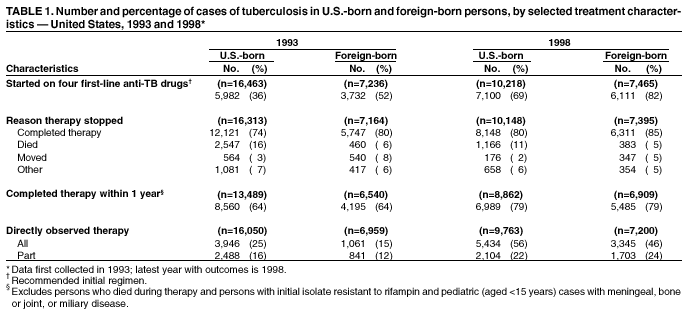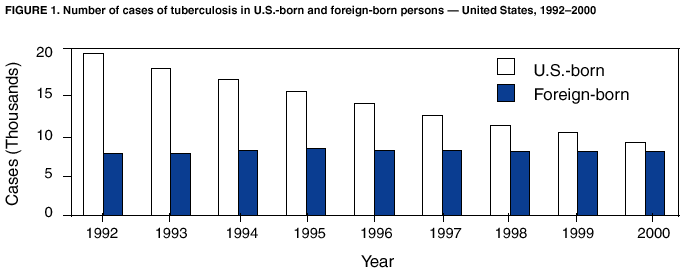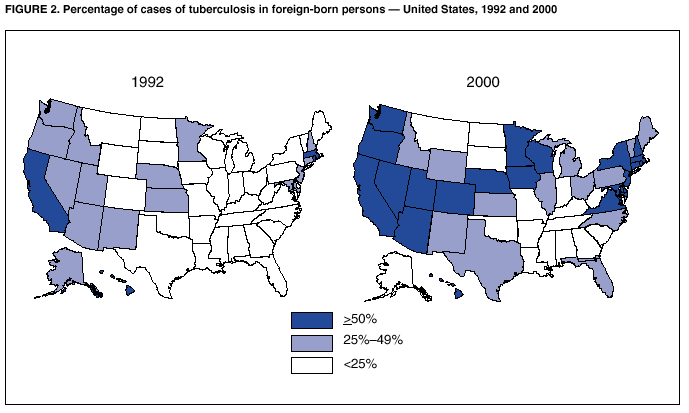 |
|
|
|
|
|
|
| ||||||||||
|
|
|
|
|
|
|
||||
| ||||||||||
|
|
|
|
|
Persons using assistive technology might not be able to fully access information in this file. For assistance, please send e-mail to: mmwrq@cdc.gov. Type 508 Accommodation and the title of the report in the subject line of e-mail. Tuberculosis Morbidity Among U.S.-Born and Foreign-Born Populations --- United States, 2000In collaboration with all state health departments, CDC conducts public health surveillance for tuberculosis (TB). This report summarizes data from the national TB surveillance system for 2000 and compares them with data from 1992--1999. During 2000, a total of 16,377 cases (5.8 cases per 100,000 population) of TB were reported to CDC from the 50 states and the District of Columbia (DC), representing a 7% decrease from 1999 (1) and a 39% decrease from 1992, when the number of cases and case rate most recently peaked in the United States. However, the case rate among foreign-born persons remains at least seven times higher than among U.S.-born persons. To address the high rate, CDC is collaborating with public health partners to implement TB control initiatives among recent international arrivals and residents along the border between the United States and Mexico and to strengthen TB programs in countries with a high incidence of TB disease. The 50 states and DC report cases to the national TB surveillance system using a standard case definition and report form (1). The case report was expanded in 1993 to include information about initial susceptibility results and treatment. Completeness of reporting to the national system is estimated to be >95% (2). Data were analyzed for cases reported during 1992--2000 using case reports updated by April 17, 2001. A U.S.-born person was defined as someone born in the United States or its jurisdictions or born in a foreign country but having at least one U.S.-born parent; others were classified as foreign born. U.S.-born and foreign-born populations in 1992 were obtained from postcensus estimates (3); those for 2000 were based on an extrapolation from the March 2000 Current Population Survey (4) to the April 2000 population. Multidrug-resistant (MDR) TB was defined as resistance to at least isoniazid and rifampin. During 2000, a total of 16,377 U.S. cases (5.8 cases per 100,000 population) of TB were reported, representing a 7% decrease from 1999 (1) and a 39% decrease from 1992 (26,673 cases; 10.5 cases per 100,000 population). Of the 16,377 cases, 8,714 cases (3.5 per 100,000 population) were reported among U.S.-born persons; 7,554 (25.8 per 100,000 population) were among foreign-born persons, representing 46% of all cases (Figure 1). In 1992, a total of 19,225 cases (8.2 per 100,000 population) were reported among U.S.-born persons; 7,270 (34.2 per 100,000 population) cases were reported among foreign-born persons, representing 27% of all cases. The number of states with >50% of their annual total of reported TB cases among foreign-born persons increased from four in 1992 to 21 in 2000 (Figure 2). Of these 21 states, California, Hawaii, Massachusetts, Minnesota, and New Hampshire had >70% of their annual total of cases among foreign-born persons. In 2000, of the 7,554 cases of TB in foreign-born persons, 3,120 (41%) occurred among persons from Central and South America or the Caribbean, and 2,463 (33%) were from the Western Pacific region*. These regions also had the largest number of persons with cases in 1992 (3,202 [44%] of 7,270 and 2,873 [40%] of 7,554, respectively). During 1992--2000, the number of cases approximately doubled among persons from the Mediterranean (167 [2%] of 7,270 and 385 [5%] of 7,554, respectively) and among persons from South-East Asia (438 [6%] of 7,270 and 748 [10%] of 7,554, respectively), and the number of cases among persons from Africa tripled (161 [2%] of 7,270 and 463 [6%] of 7,554, respectively). The proportion of patients with MDR TB decreased from 486 (3%) of 17,684 in 1993 to 141 (1%) of 12,056 in 2000 (the smaller denominator reflects the subset of culture-positive cases with initial susceptibility results). However, of the total number of reported MDR TB cases, the proportion occurring in foreign-born persons increased from 31% (150 of 486) in 1993 to 72% (101 of 141) in 2000. The proportion of TB patients placed on a recommended initial treatment regimen (i.e., isoniazid, rifampin, pyrazinamide, and streptomycin or ethambutol [6]) increased during 1993--1998. (The latest year that data were available on treatment outcomes was 1998 because of the extended duration of treatment for TB.) The proportions of patients who completed treatment within 1 year and who were treated with directly observed therapy (at least for a portion of treatment) also increased during this period (Table 1). Reported by: Div of Tuberculosis Elimination, National Center for HIV, STD, and TB Prevention, CDC. Editorial Note:During 1992--2000, TB case rates in the United States decreased for U.S.-born and foreign-born persons; however, the decrease among foreign-born persons was less substantial. Decreases in the number and proportion of MDR TB cases also occurred. The overall improvement is consistent with the finding of an increasing proportion of patients receiving initial four-drug regimens, completing treatment within 1 year, and being treated with directly observed therapy. The findings in this report are subject to at least one limitation. Case rates by birth country should be interpreted with caution because final population estimates based on April 2000 U.S. census data were not available. Despite the decrease in case rate among foreign-born persons, approximately half of TB cases in the United States in 2000 occurred in this population, and the case rate was seven times greater in this population than among U.S.-born persons. To address the high rate, CDC is collaborating with other national and international public health organizations 1) to improve overseas screening of immigrants and refugees by developing systematic tools for monitoring and evaluating the screening process; 2) to improve the current notification system that alerts local health departments about the arrival of immigrants or refugees with suspected TB to assist patients in obtaining a medical evaluation and, if necessary, in completing a course of recommended drugs; 3) to improve coordination of and communication about TB control activities between the United States and Mexico to ensure completion of treatment among TB patients who cross the border; and 4) to test recent arrivals from high-incidence countries for latent TB infection and ensure completion of treatment. In addition, CDC continues to strengthen collaborations with international partners, including the World Health Organization, to improve TB control in high-incidence countries. Accelerating national TB elimination activities will require broader prevention efforts to evaluate and address the needs of other high-risk groups such as persons with HIV and those with limited access to medical care and adequate housing and nutrition. Low-incidence areas need to maintain the capacity and expertise to respond to persons with TB. CDC is updating its plan (7) to ensure that prevention activities are undertaken with optimal coordination among national and international public health partners. References
* Designated by the World Health Organization (5). Table 1  Return to top. Figure 1  Return to top. Figure 2  Return to top.
Disclaimer All MMWR HTML versions of articles are electronic conversions from ASCII text into HTML. This conversion may have resulted in character translation or format errors in the HTML version. Users should not rely on this HTML document, but are referred to the electronic PDF version and/or the original MMWR paper copy for the official text, figures, and tables. An original paper copy of this issue can be obtained from the Superintendent of Documents, U.S. Government Printing Office (GPO), Washington, DC 20402-9371; telephone: (202) 512-1800. Contact GPO for current prices. **Questions or messages regarding errors in formatting should be addressed to mmwrq@cdc.gov.Page converted: 2/7/2002 |
|||||||||
This page last reviewed 2/7/2002
|